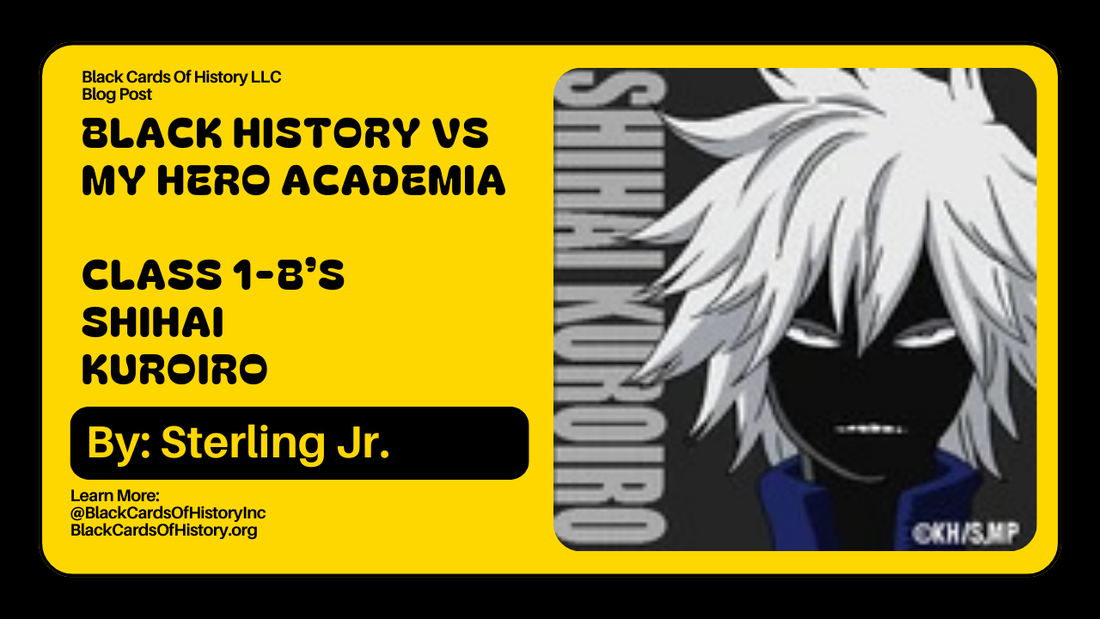Shadows of Change: Kuroiro’s Artistic Lens on Black Legacy
Rise Beyond Legacy x My Hero Academia Final Season Preblogs
By Sterling, Founder of Black Cards Of History LLC
Intro: Where Mystery Meets Meaning
If anyone was going to take Black History Month and turn it into something hauntingly beautiful and intellectually captivating, it’s Shihai Kuroiro. The “Prince of Shadows” in Class 1-B isn’t your average hero-in-training. His aesthetic leans into the eerie and abstract, his tone often poetic, and his worldview shaped by nuance and darkness. But in that very darkness is where Kuroiro finds light — or rather, legacy.
I’d rate Kuroiro an 8/10 in terms of how deeply and authentically he’d engage with Black History Month. His approach wouldn’t be loud or flashy. It wouldn’t be surface-level either. It would be shadowy, reflective, and deeply symbolic — the kind of tribute that leaves you thinking long after the video fades to black.
Section One: Not Just a Theme — A Mission
Black History Month isn’t just about commemorating the past; it’s about recognizing how those stories shape ambition, identity, and justice. That’s why I imagine Kuroiro wouldn’t view it as a month of obligation or performative activism. For him, it would be a mission to illuminate what has been buried — voices overshadowed, artists ignored, revolutionaries silenced.
He’d say something like: "History hides what scares it — but in that fear lies the power to change the world."
And honestly? He’d be right.
Section Two: From Darkness, Legends Rise
As someone who embraces shadows and subtlety, Kuroiro would be drawn to the less-commercialized stories of Black history — the ones that often get left out of classroom conversations or mainstream documentaries. He would likely immerse himself in the lives of overlooked creators: Black surrealist poets, radical jazz composers, freedom fighters who weaponized silence as resistance.
He wouldn’t just name-drop historical figures for clout. He’d embody their spirit. He’d narrate their legacies with reverence, mood, and grace. His research would show — not just in facts, but in tone, visual composition, and emotional impact.
Section Three: YouTube Assignment — “Shadows of Change: The Unseen Legends of Black History”
Now here’s where he would absolutely thrive: the YouTube assignment. Picture it.
Opening shot: A black-and-white silhouette of a jazz saxophone emerging from fog.
Narration begins: “Some legends never stood in the spotlight — they created it.”
Cut to visuals: A montage of shadowy photos, handwritten lyrics, protest signs, closed fists, and candlelit vigils.
Music: A blend of lo-fi ambiance, spoken word overlays, and soft strings.
Kuroiro’s video would likely focus on figures like:
- Marsha P. Johnson, whose work in the shadows of the LGBTQ+ rights movement often goes uncredited.
- Sun Ra, the Afrofuturist jazz composer who believed Black people were from the stars — and who made space for their cosmic identity.
- Assata Shakur, whose life in exile speaks volumes about systemic fear and unbreakable resolve.
The narration would be poetic, sometimes cryptic, but always anchored in reverence and clarity. It would feel like walking through a dream or a ritual — and it would absolutely leave an impression.
Section Four: Why This Matters — Black Excellence & Ambition
What I appreciate most about Kuroiro’s imagined approach is his humility. He doesn’t present himself as an expert or a savior. He simply bears witness. In a world obsessed with spotlight and virality, his choice to elevate others from the shadows is a radical form of justice.
And that ties into a bigger conversation: how Black excellence isn’t always loud. It doesn’t always wear medals. Sometimes it exists in protest poetry, behind-the-scenes movements, and underground art. And for someone like Kuroiro, whose identity thrives in subtlety, this is where he would genuinely connect — not just perform.
He reminds us that ambition doesn’t have to be aggressive. It can be graceful. It can be layered. It can challenge you not to look at the loudest person in the room, but the one quietly rewriting the narrative in the corner.
Closing: The Darkness Has Something to Say
Kuroiro would end his video not with a call to action, but a challenge:
“When the lights go out, will you still see them?”
“Will you remember the ones history tried to erase?”
In his own poetic and brooding way, he would spotlight the fact that Black history is not a monolith. It’s jazz and revolution. Silence and rage. Shadows and fire.
And as the founder of Black Cards Of History LLC, I salute that. Because sometimes, the most powerful tributes are the ones that make you lean in — not scroll past.

